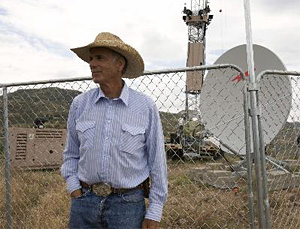 |
 |
 |
 Technology News | October 2007 Technology News | October 2007  
Boeing, Bush Pressed to Fix Glitches in Electronic Border Fence
 Jeff Bliss - Bloomberg Jeff Bliss - Bloomberg
go to original


| | Tom Kay walks on his ranch in Arivaca, Arizona, on October 1, 2007. The tower with mounted cameras, sensors, radar and satellite communications in the background is one of nine that have been built along border between Arizona and Mexico as part of the initial phase of the Secure Border Initiative Net. (Chris Hinkle/Bloomberg News) |
President George W. Bush's vision of securing the U.S.'s southwestern border with a system of sensors and cameras faces a crucial field test this month as Boeing Co. tries to fix problems that have delayed the $8 billion project.

Cameras that take too long to focus and radar images obscured by falling raindrops were among the glitches that caused Boeing to miss a June deadline for the first stage of a so-called virtual fence along a 28-mile stretch in Arizona.

If the company gets the system to work, it would be in line for a lucrative payday, while the U.S. might be able to minimize the need for more costly physical barriers that are resented by Mexico. Bush's moribund immigration overhaul might also get a boost if confidence in border security rises.

But if administration officials can't demonstrate the system's effectiveness, "they completely blow their own credibility" on immigration enforcement, said Jessica Vaughan, an analyst at the Washington-based Center for Immigration Studies, which favors tighter border controls.

The Arizona project, which features nine towers bristling with cameras, sensors, radar and satellite-communication links, is the initial phase of the Secure Border Initiative Net, a program introduced by the Department of Homeland Security in 2005.

Thousands of Miles

Nothing on the scale of SBInet has ever been attempted. DHS plans an electronic surveillance system to police the 2,000-mile southwestern border by 2013 and eventually the 5,000-mile northern border -- a distance almost double that spanned by the Great Wall of China.

The system must operate in harsh desert temperatures and overcome the difficulties of merging information from all of its sensors and cameras into a coherent picture.

The danger "is to underestimate the difficulty of making it work in the real world," said Mohan Trivedi, director of the Computer Vision and Robotics Research Laboratory at the University of California, San Diego.

In June, Boeing engineers working on the initial phase discovered that when cameras turned toward a target, they often weren't focused or positioned at the right height. Key information from sensors and cameras also wasn't being transmitted to Border Patrol vehicles.

"You'd think there would be lab experimentation before you go out and embarrass everybody," said Representative Mark Souder, an Indiana Republican who favors reliance on physical barriers.

Burden of Proof

Boeing has contracts for only $67 million for its work so far and has to prove its competence in early tests before it gets the go-ahead to wire the whole southwestern border, said Brad Benson, a spokesman for DHS's Customs and Border Protection unit.

Recent performance improvements are encouraging, Benson said. The Border Patrol is using the system to nab some illegal immigrants south of Tucson. "We still believe Boeing is going to get it done," he said.

Chicago-based Boeing, which replaced the management team on the Arizona project in August, is now updating software to prepare for another round of tests later this month.

In Arivaca, Arizona, a border town of 1,200 near the SBInet towers, many residents aren't sanguine about the technology. Thousands of immigrants head toward Arivaca and points north on paths that snake up mountains and down treacherous ravines.

Arivaca rancher Tom Kay, 65, said he's losing as much as $30,000 a year from cattle that die after swallowing plastic debris discarded by immigrants, or that wander off through holes cut in his fence.

`An Ungodly Amount'

"I've been overrun," Kay said. "It costs me an ungodly amount."

Rob Kasulaitis, 63, said he's grown fearful of deer-hunting in the surrounding hills after coming upon a sleeping group of marijuana smugglers.

Kasulaitis said his ranch, with its six-foot-high clumps of Sacaton grass to feed his cattle, provides cover for illegal migrants. He often finds cast-off backpacks and clothes in his field.

"You could have an army of people out here and you couldn't see them," he said.

T.J. Bonner, president of the National Border Patrol Council, a union that represents 12,000 agents, said, "It's a mistaken notion that everyone can be stopped at the border."

Tighten Management

In Congress, there are concerns about the cost of electronic monitoring, which have been estimated as high as $30 billion. Last year, lawmakers required the department to tighten management of the project.

"Both the U.S. government and Boeing as prime contractor have to stay on top of that very closely to make sure the setback doesn't become a failure," said Richard Stana, director of homeland security issues at the Government Accountability Office, Congress' auditing arm.

Boeing spokeswoman Deborah Bosick referred all questions to the department.

Back in Arivaca, rancher Kay said Boeing can't get the system working soon enough. On a tour of his ranch earlier this month he ran into two Border Patrol agents who told him they had found new paths cutting across his property and a floodgate that had been broken to allow immigrants to crawl through a culvert.

"You can't spend enough money to stop these people," Kay said.

To contact the reporter on this story: Jeff Bliss in Washington at jbliss@bloomberg.net. | 
 | |
 |



